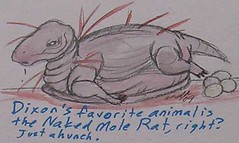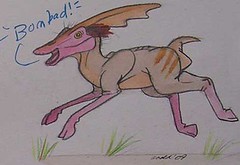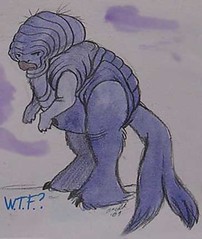I am sure you remember the Lank. When I drew him all those months ago, I noted that he was the second most anatomically unlikely animal in the book - if I was remembering things right, as I hadn't read it in a while. Now that I have just read it, I can say with some confidence that the lank is the FOURTH most anatomically unlikely animal in the book.
This guy right here is the most anatomically unlikely animal in the entire book. He's a Wyrm. He's an armless, tail-less, long-necked burrowing creature who for some reason has retained stumpy little baby legs. And he is descended from swift-running, long-legged, long-armed, long-tailed small theropods.
This thing only makes sense if there were no other more qualified long-bodied burrowing animals at all available in this world to fill the niche. (It'd still look awkward, but it would be slightly more believable.)
Next up is the Gestalt. It seems like every one of Dougal Dixon's speculative biology books has at least one vertebrate that has adopted a colony or hive-like lifestyle. Some, like the Gestalt, even go so far as to have one baby-making Queen (pictured) and dozens and dozens of workers. At least the Pachycephalosaur-descended Gestalt isn't as unappealing as the Hivers (ant-like humans) from the already very disturbing Man After Man.
Our next animal brings us to my unofficial Dougal Dixon Speculative Biology Book Drinking Game. Anytime you come upon the following adaptation in an animal, take a shot:
On top of that, they now remind me of somone else...
(Shudder...)
This is getting to be a little longer than I expected. I'll stop arbitrarily at this fellow. He's a Balaclav, an ornithopod of the snowy mountains. And he is the third most anatomically unlikely animal in the book. He's got thick fur on his noticeably skinny legs and his tail - and no, I am not making that odd "forked" effect up. In the original illustration, he almost looks like a tripod. And, of course, he has rolls and rolls of fat protecting the rest of his body from the cold. This is another creature design that is downright ugly. Poor thing.








